Powerline communication (PLC), or powerline for short, also known under the manufacturers’ designations PowerLAN or HomePlug AV, is a technology which enables existing electrical lines in the low voltage grid to be used for a local data transmission network, instead of additional cabling. It is especially popular in private, where it is used to spread the internet signal in homes.

Powerline is already used by lots of devices that are connected to each other via the power supply system, for example telephones, alarm systems and CCTV cameras. Home automation and the internet of things are also suitable applications, due to the low data volumes involved. It can also be used for controlling an intelligent power network, or ‘smart grid’.
In e-mobility, devices such as the charging station and the vehicle are connected by cable in order to charge. Thanks to powerline, the charging cable can also be used to transfer data, in order to exchange technical parameters, check authorisations and transfer billing data. In these applications, bidirectional data communication is realised according to the EN ISO 15118 series of standards and supports vehicle-to-grid applications. The protocol used is the HomePlug Green PHY standard, which is a simplification of the HomePlug AV protocol standard. This considerably reduces the performance requirements on the control processor, which leads to a significantly reduced power dissipation of the system.

Circuit diagram of a PLC transformer
In order to couple the data signal into the power line, inductive transformers are used, which usually have one winding each for the transmit and receive signal and one winding for the mains line. Depending on the chipset and the mains voltage range, different turns ratios are required. The desired transmission is as low-loss as possible in the used frequency range.
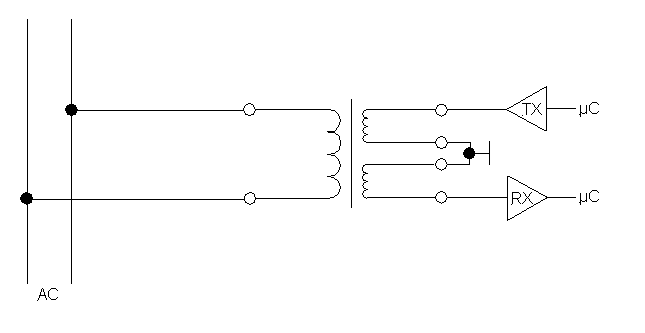
- 1:1:1 PLC transformer
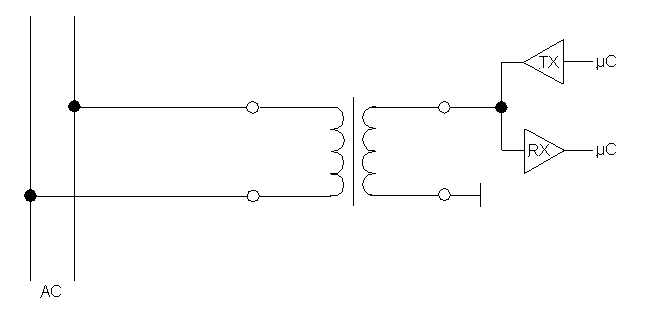
- 1:1 PLC transformer
Small design and large bandwidth
Components for high-frequency transmission are being miniaturised more and more. Additionally they should guarantee high signal quality. At the same time, high safety requirements with large clearance and creepage distances and high insulation voltages are placed on communication technology devices, for example in the standards DIN EN 60664, 60950 and 62368.
Powerline transformers from NEOSID are available in various designs. All designs are suitable for automatic assembly and reflow as well as vapour phase soldering.
By using special winding arrangements and materials, reinforced and double insulation with voltage strengths of several kilovolts are also possible. A thorough quality inspection ensures compliance with the high requirements.
PLC transformers for mains voltage applications
Depending on the operating voltage of the carrier network for a Powerline data transmission, there are different requirements for the insulation of the windings in the transformer. If the operating voltage is at mains voltage level (e.g. 230VAC), special requirements are placed on the insulation voltage and the clearances and creepage distances.
Our PLC transformer in the RM-R6 housing offers a customised design for these applications, which meets the insulation requirements with the smallest dimensions.
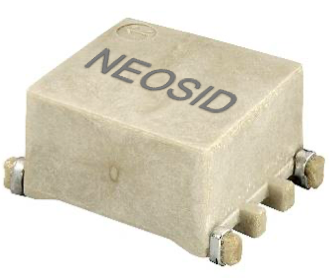
- PLC transformer in package SM-R6
Technical data:
- NEOSIDDimensions (l x w x h): 10.8 x 8.8 x 5.5 mm
- Typical inductance values 2 µH - 30 µH
- Operating frequency 1 kHz to 10 MHz
- Power transmission up to 1 Watt
- Clearance and creepage distances up to 8mm
- Insulation voltage up to 4kV
- Winding ratio 4:1:5
Transmission characteristic:

This PLC transformer has a linear insertion loss up to F = 10MHz. The design allows the transmission of signal power up to P = 1 Watt.
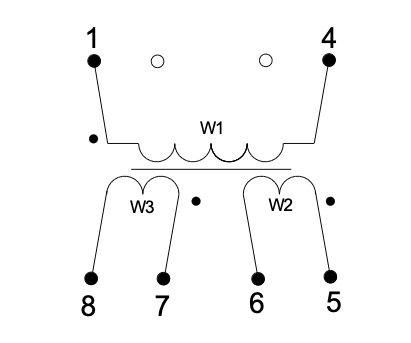
- Pinout PLC transformer
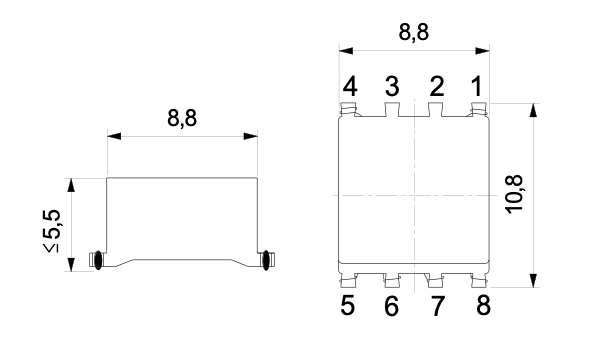
- Package SM-R6
Alternative pin assignments and winding ratios can be created on request to realise an ideal adaptation to circuit designs and layouts for different powerline chipsets.
PLC transformers for low voltage applications
In the low voltage range, PLC transformers with a turns ratio of 1:1:1 are generally used. Due to the lower insulation voltage requirements, more compact designs can be realised.
PLC transformer 1:1:1, type SM-R6

- PLC transformer in package SM-R6
Technical data:
- NEOSIDDimensions (l x w x h): 10.8 x 8.8 x 5.5 mm
- Typical inductance values 2 µH - 30 µH
- Operating frequency 600 kHz to 30 MHz
- Power transmission up to 1 W
- Winding ratio 1:1:1
Transmission characteristic:

Various pin assignments exist:
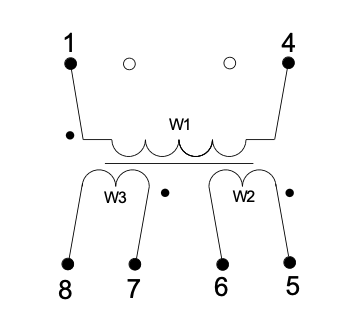
- Pinout A PLC transformer
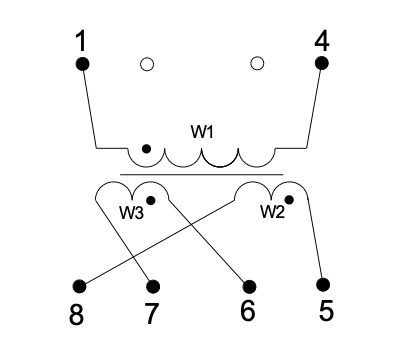
- Pinbelegung B PLC-Übertrager
PLC transformer 1:1:1, type SM-T308
With this PLC transformer we use our know-how in the development and production of miniaturised soft magnetic ferrite cores. The winding core and the base plate are made of a single piece ferrite core. This results in a miniaturised component, which further reduces the space required on the PCB and the number of components. The one-piece shape continues to offer maximum stability and resistance to various environmental influences combined with excellent transmission behavior up to 100MHz.
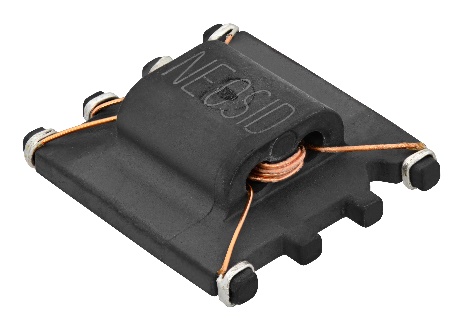
- PLC transformer in package SM-T308
Technical data:
- Dimensions (l x w x h): 10.8 x 9.0 x 3.2 mm
- Typical inductance values 1 µH - 10 µH
- Operating frequency 600 kHz to 100 MHz
- Power transmission up to 250 mW
- Winding ratio 1:1:1
Transmission characteristic:

PLC transformer 1:1:1, type SM-TP306
We also use a one-piece ferrite core for this transformer version. The component only has the necessary six connections and therefore requires the least space of all PLC transformers on the PCB.
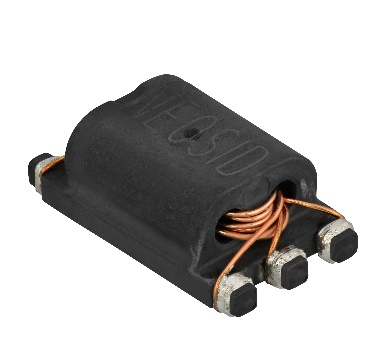
- PLC transformer in package SM-TP306
Technical data:
- Dimensions (LxWxH): 9.6 x 5.4 x 4.0 mm
- Typical inductance values 1 µH - 10 µH
- Operating frequency 600 kHz to 100 MHz
- Power transmission up to 250 mW
- Winding ratio 1:1:1
Transmission characteristic:

Alternative numbers of windings, pin assignments, winding ratios and inductance values are available on request in order to realise an ideal adaptation to the circuit designs and layouts for different powerline chipsets.
Customised component designs are our speciality! With our special injection moulding process for ferrite cores, we produce a precise fit for your application - individually according to the defined task and exactly in the specified installation space.
Tell us your requirements - we will develop the right solution for you!
Have we aroused your interest? Then contact us about the latest generation of powerline transformers.










